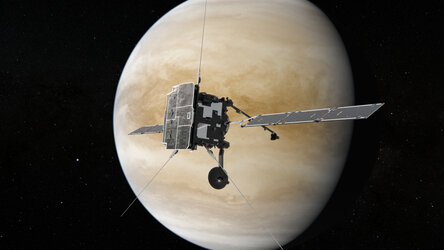ESA's fleet rides the storm
The highly unusual activity of the Sun this week has had an amazing effect on our magnetosphere, but what about ESA's spacecraft, orbiting high above the Earth or en route to other worlds?
The magnetosphere is the magnetic shield surrounding our planet which protects the Earth from most of the charged particles that are blasted across interplanetary space by explosions on the Sun.

But spare a moment to think about some of ESA's spacecraft which are now on missions which take them away from Earth, some outside the magnetosphere and receiving the full blast.
ESA mission scientists are aware of how disruptive these energetic particles could be to their spacecraft and have been monitoring the situation closely. They are working closely with experts in space weather from ESA's Electromagnetics and Space Environment Division.

Fortunately, most of these spacecraft also have on-board radiation monitors so, even without the early warnings given by the ESA/NASA SOHO solar observatory, scientists are always alerted in time for them to take precautions.
On its way to the Red Planet, ESA's Mars Express was hit by the cloud of charged particles but was designed with adequate protection for these events. Most of its instruments are currently switched off because they are not needed until the spacecraft reaches Mars, and so they escaped any data loss or damage to delicate components.
The only major effect of the solar activity on SMART-1, spiralling its way to the Moon, has been a disruption to the operation of the 'ion' engine. The engine is being used to boost SMART-1's orbit out towards the Moon. At one point, the ion engine automatically shut down, but restarted itself later with no problems. This is a temporary condition and will disappear when the extreme solar activity subsides.
At the same time, radiation monitors on board other ESA Science spacecraft in highly elliptical orbits had detected radiation, probably coming from the solar flare. These spacecraft, XMM Newton and Integral, are safe and fully operational. Only their most-sensitive instruments have been switched off to prevent damage. In fact, XMM-Newton was already in a safe 'hibernation' mode because it was passing through the Van Allen radiation belts at that time.
In 2001, XMM-Newton survived the largest solar flare ever recorded, and mission scientists had no reason to be concerned about the effects of this week's events. Integral had also stopped its operations and switched itself to a 'safe' mode.















 Germany
Germany
 Austria
Austria
 Belgium
Belgium
 Denmark
Denmark
 Spain
Spain
 Estonia
Estonia
 Finland
Finland
 France
France
 Greece
Greece
 Hungary
Hungary
 Ireland
Ireland
 Italy
Italy
 Luxembourg
Luxembourg
 Norway
Norway
 The Netherlands
The Netherlands
 Poland
Poland
 Portugal
Portugal
 Czechia
Czechia
 Romania
Romania
 United Kingdom
United Kingdom
 Slovenia
Slovenia
 Sweden
Sweden
 Switzerland
Switzerland































